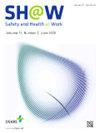Development of the Quality of Life Scale for Shift-working Nurses
IF 2.9
3区 医学
Q1 PUBLIC, ENVIRONMENTAL & OCCUPATIONAL HEALTH
引用次数: 0
Abstract
Background and aim
Shift work is known to have a significant impact on the health and well-being of nurses, and there is a need for practical tools to assess this impact. This study introduces the “Quality of Life Scale for Shift-Working Nurses” (QoLS-SWN), which was developed to provide a reliable and valid tool for assessing the effects of shift work on nurses' health and well-being.
Methods
This study employed a methodological research design to develop and validate a new scale for assessing the quality of life of shift-working nurses. Data were collected from two samples of nurses working in various hospitals. The first sample (n = 202) was used for exploratory factor analysis (EFA) to identify the scale's underlying factor structure. The second sample (n = 246) was used for confirmatory factor analysis (CFA) to validate the identified structure. The development process included an extensive literature review, expert consultations, and pilot testing. Factor analysis and reliability tests were conducted to ensure that the scale is highly reliable.
Results
The QoLS-SWN demonstrated excellent reliability, with a Cronbach's alpha of 0.95, and factor loadings ranging from 0.56 to 0.90. The scale comprises three dimensions: physical and mental exhaustion, health risks and job safety, and social and psychological interactions, explaining 71.89% of the total variance. CFA affirmed the structural validity of the scale, with fit indices indicating a good model fit (CMIN/df = 2.33, GFI = 0.86, IFI = 0.95, TLI = 0.94, CFI = 0.95, RMSEA = 0.07).
Conclusion
The QoLS-SWN is a reliable and valid tool for measuring the impact of shift work on nurses' quality of life. By providing insights into the multifaceted consequences of shift work, the scale may guide the development of targeted interventions to enhance nurses' quality of life. This scale can inform nursing practice and policy, ultimately improving nurse well-being and patient care outcomes.
轮班护士生活质量量表的编制
背景和目的众所周知,轮班工作对护士的健康和福祉有重大影响,需要实用的工具来评估这种影响。本研究引入“轮班护士生活质量量表”(QoLS-SWN),为评估轮班工作对护士健康和幸福的影响提供一个可靠和有效的工具。方法采用方法学研究设计,编制并验证一套新的轮班护士生活质量评估量表。数据从两个在不同医院工作的护士样本中收集。第一个样本(n = 202)用于探索性因子分析(EFA),以确定量表的潜在因素结构。第二个样本(n = 246)用于验证性因子分析(CFA)来验证鉴定的结构。开发过程包括广泛的文献回顾、专家咨询和试点测试。进行因子分析和信度检验,确保量表具有较高的信度。结果QoLS-SWN具有良好的信度,Cronbach's alpha为0.95,因子负荷范围为0.56 ~ 0.90。该量表包括三个维度:身心疲惫、健康风险和工作安全、社会和心理互动,解释了总方差的71.89%。CFA证实了量表的结构效度,拟合指标表明模型拟合良好(CMIN/df = 2.33, GFI = 0.86, IFI = 0.95, TLI = 0.94, CFI = 0.95, RMSEA = 0.07)。结论QoLS-SWN是衡量轮班工作对护士生活质量影响的可靠、有效的工具。通过深入了解轮班工作的多方面后果,该量表可以指导制定有针对性的干预措施,以提高护士的生活质量。该量表可以为护理实践和政策提供信息,最终改善护士福祉和患者护理结果。
本文章由计算机程序翻译,如有差异,请以英文原文为准。
求助全文
约1分钟内获得全文
求助全文
来源期刊

Safety and Health at Work
Social Sciences-Safety Research
CiteScore
6.40
自引率
5.70%
发文量
1080
审稿时长
38 days
期刊介绍:
Safety and Health at Work (SH@W) is an international, peer-reviewed, interdisciplinary journal published quarterly in English beginning in 2010. The journal is aimed at providing grounds for the exchange of ideas and data developed through research experience in the broad field of occupational health and safety. Articles may deal with scientific research to improve workers'' health and safety by eliminating occupational accidents and diseases, pursuing a better working life, and creating a safe and comfortable working environment. The journal focuses primarily on original articles across the whole scope of occupational health and safety, but also welcomes up-to-date review papers and short communications and commentaries on urgent issues and case studies on unique epidemiological survey, methods of accident investigation, and analysis. High priority will be given to articles on occupational epidemiology, medicine, hygiene, toxicology, nursing and health services, work safety, ergonomics, work organization, engineering of safety (mechanical, electrical, chemical, and construction), safety management and policy, and studies related to economic evaluation and its social policy and organizational aspects. Its abbreviated title is Saf Health Work.
 求助内容:
求助内容: 应助结果提醒方式:
应助结果提醒方式:


